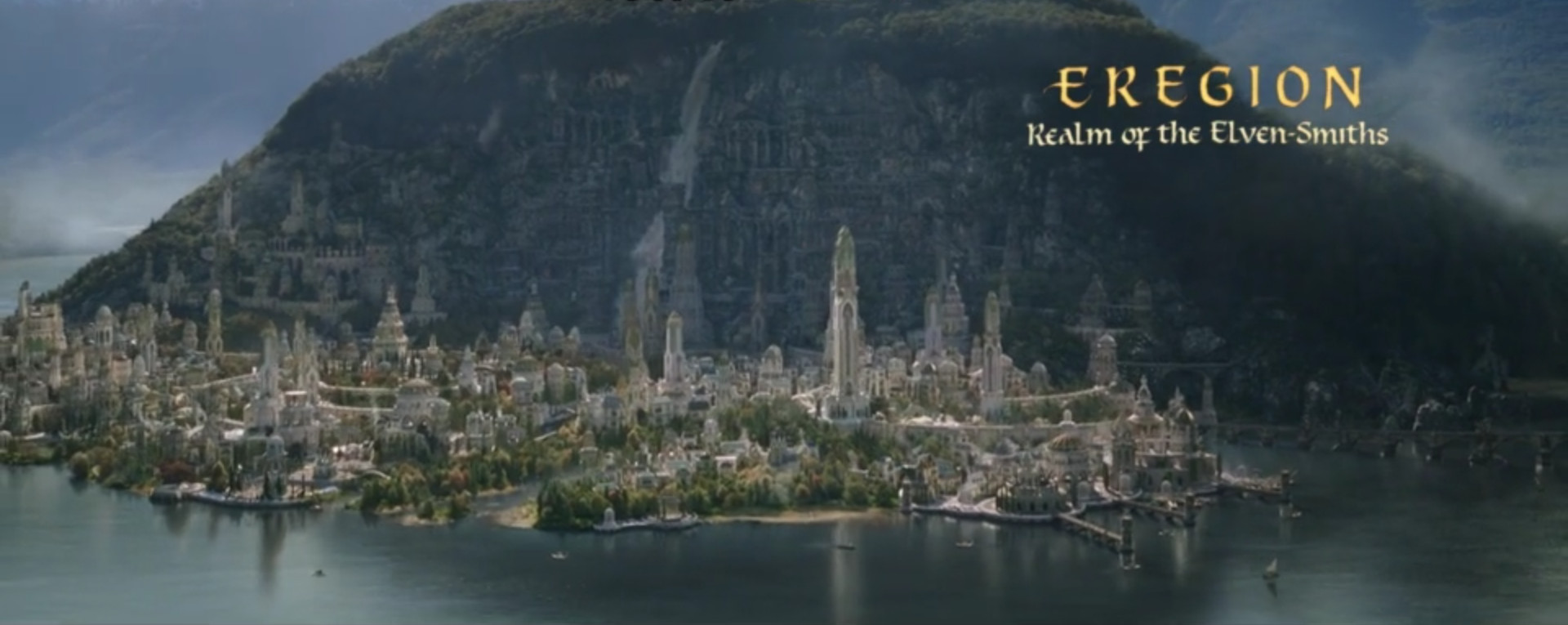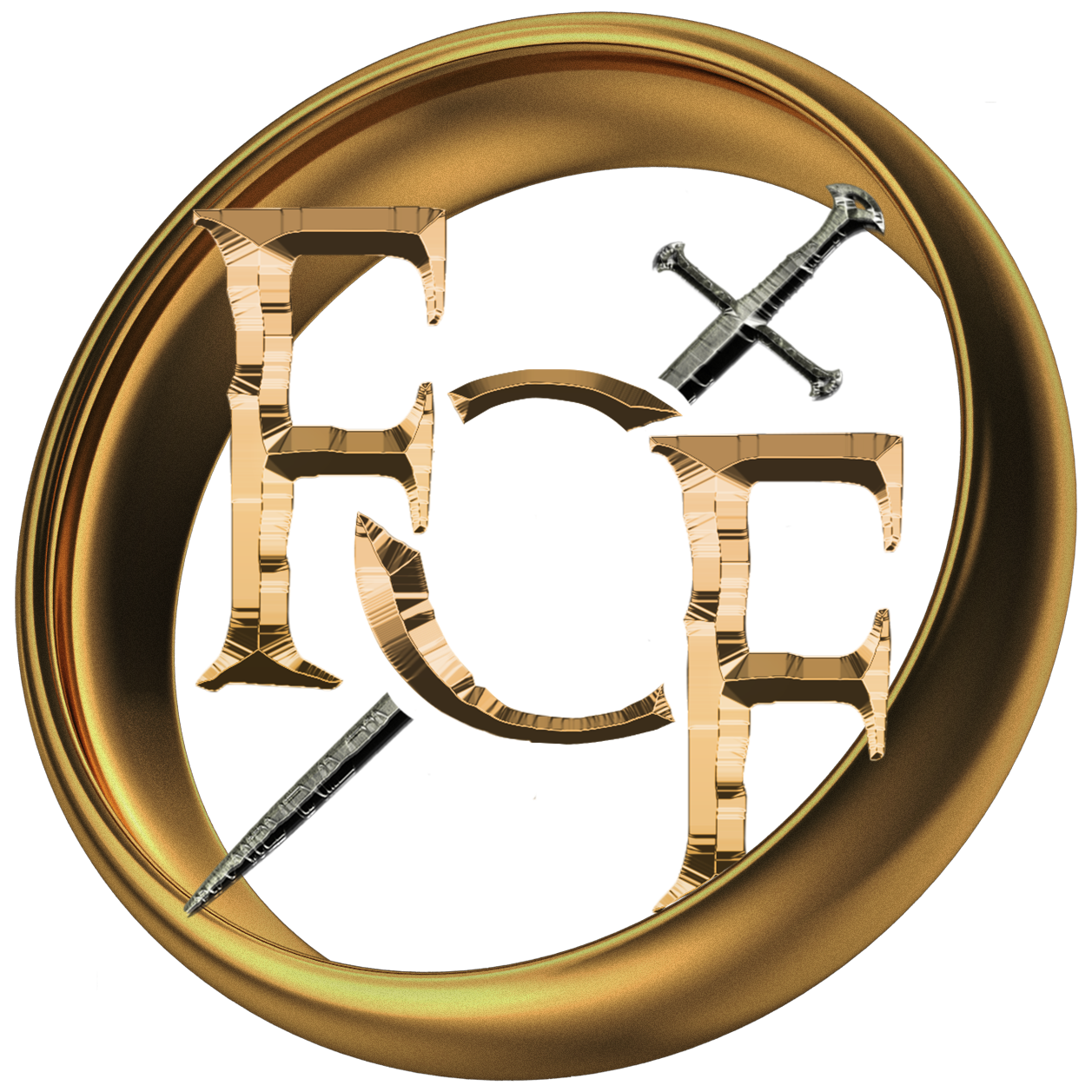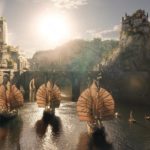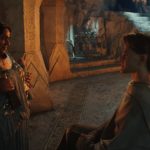
The Sword That Was Broken: “Adrift”
“Renewed shall be blade that was broken,
The crownless again shall be king.”―”All That Glitters Is Not Gold”, “Strider”, The Fellowship of the Ring
This is my analysis of the second episode of The Rings of Power: “Adrift”. It will probably be the last time I include an episode summary. In future articles I will expect the reader to have already seen the episode.
Summary
Please be informed that everything from here until the end of the article likely includes spoilers for the show.
Adrift at sea, by starlight Galadriel begins to swim back toward Middle-earth. In the daytime she encounters a raft also adrift at sea, occupied by several survivors of a sea monster attack. They regard Galadriel with some suspicion at first, but when they discover she is an Elf, and when the sea monster returns soon after, their suspicion turns to hostility, and they throw her from the raft. Galadriel swims away furiously as the sea monster plows into the raft at full speed. One of the survivors unlashes the part of the raft he is standing on and manages to drift away before the sea monster hits the raft, leaving his companions to their fate. He offers Galadriel a place on the raft, which she hesitantly accepts. Galadriel learns his name is Halbrand, and he is from the Southlands. He says his home was burned by Orcs. At the mention of Orcs, Galadriel offers to return with him to the Southlands to fight them. However, Halbrand says he has other plans. The raft is caught in a storm. Galadriel lashes herself to a pole, but the pole is struck by lightning and falls overboard, pulling Galadriel down with it. Halbrand jumps in the water after her and uses her knife (Finrod’s knife) to cut the rope, releasing Galadriel and allowing her to float to the surface.
Nori accidentally falls into the burning meteor crater but discovers that the fire is not hot. The man in the meteor crater wakes up, giving Nori a fright. Nori yells and the man yells too. The flames are put out and rocks levitate. Finally the man stops and collapses unconscious to the ground, at which point the rocks fall back down, and the flames spring up again. Nori insists they can’t leave the man there to be eaten by wolves and Poppy reluctantly goes along with her. Sadoc discusses the “starfall” with Malva and Marigold. He is concerned about what appears to be a bad omen and wants to break camp as soon as possible. However, there is a festival coming up soon, and he agrees to wait until after the festival. Nori and Poppy steal various equipment from the Harfoot settlement, including a wheelbarrow, which they use to transport the Meteor Man to shelter. While they pause to argue the wheelbarrow starts rolling downhill and they run after it. Finally they get him to shelter. Nori says she has a feeling the stranger is someone important. The next day Nori finds him drawing signs in the ground. She offers him snails to eat, which he does, shells and all. Nori begins trying to communicate. She wants to know who his people are. He begins drawing furiously in the ground until his stick breaks. Meanwhile, as Poppy’s father Largo is helping set up a tall pole for the festival, a rope suddenly breaks and the pole pushes him back, twisting his foot. The elder women of the settlement begin speculating whether or not he will be able to migrate. In the evening Nori and Poppy find Meteor Man staring at the stars. They are carrying lanterns powered by fireflies. Meteor Man controls the fireflies, causing them to outline a constellation of significance in the sky. Nori doesn’t recognize the constellation, but she decides they have to find it and get Meteor Man to some place from which it can be seen. Poppy notices that the fireflies are starting to die and sheds a tear.
In Eregion Celebrimbor tells Elrond of his ambition to use his skills for peaceful purposes. In order to achieve this ambition, he needs to build a new forge that will burn hotter than any that have been previously built. However, he needs workers to build it. Elrond suggests employing the Dwarves, who live in nearby Khazad-dûm. Prince Durin IV of Khazad-dûm is his friend, so he believes he will be able to accomplish Celebrimbor’s task easily. However, at the West Gate of Khazad-dûm Elrond is refused entry. Elrond appeals to his friendship with Prince Durin, and is told that Durin refuses to let him in. Seeing no other way to accomplish his aim, Elrond invokes the rite of Sigin-tarâg. On this he is permitted to enter. The rite is apparently a trial-by-endurance traditional to the Longbeard Dwarves―the tribe of Dwarves who live in Khazad-dûm, and are ruled at present by Durin III. The rite involves breaking rocks with a hammer. If Durin wins the contest, Elrond is banished from Khazad-dûm forever; however, if Elrond wins, he is granted a single request. For some time the two appear evenly matched. However, after a while Elrond begins to get a bit winded. He breaks a hammer and is handed another. However, he sets it down and cedes the contest. At the same time, he requests Durin to escort him out personally, which Durin accepts. On the way out Elrond finds out that he has offended Prince Durin by not communicating with him for twenty years, which to an Elf seems like a small amount of time, but to Durin seems much longer. He has missed Durin’s wedding and the birth of two children. Elrond apologizes to Durin and offers to apologize to his family as well. Durin agrees, but insists he leave as soon as he has done so. However, when Durin’s wife Disa meets Elrond, she insists on having him stay for dinner. Durin tries to resist, but eventually his wife and Elrond convince him to present Elrond’s request to his father, King Durin III. When he does so, the King speaks disapprovingly of his son’s soft spot for Elves, and insists that the timing of Elrond’s visit must mean that the Elves have somehow learned of a secret the Dwarves are keeping. With the Prince watching, King Durin opens a small wooden chest to reveal its shining contents, presumably the secret they are keeping from the Elves.
In the ruins of Hordern village, Arondir and Bronwyn notice that there are no bodies to be found. They go to the house of some acquaintances of Bronwyn and find a hole in the floorboards. Arondir jumps into the hole, finding a long tunnel, and tells Bronwyn to run to Tirharad to warn its inhabitants. Arondir travels along the tunnel for a while. He hears someone else nearby and runs away, swimming through water. As he waits for his pursuer to surface, he is grabbed by hands with long fingernails and pulled away. At Bronwyn’s cottage, Theo hears what he thinks are mice and begins angrily smashing the floorboards. Then he sees an eye peering up at him through the floorboards. Meanwhile Bronwyn shows up at the tavern, but people don’t take her warnings seriously. She returns home to find Theo hiding in a cupboard. They hear someone coming nearer, and Theo urges her to go away. She doesn’t want to leave Theo, though, so she hides in a closet. While they are hidden, and Orc climbs up through the hole in the floorboards. With nowhere to run to, Theo and Bronwyn fight the Orc together, and eventually succeed in killing it. Bronwyn takes its head to the tavern as proof of the danger they are all in. The residents of Tirharad agree to evacuate the village and go to the Elves’ tower. As Theo is packing, he takes out the broken sword. Blood from his wounds (from the Orc fight) is drawn towards the sword’s hilt, and when it touches, the sword begins reconstituting itself. Bronwyn calls to him from outside, asking if he is ready. He says he is ready and goes out to join the evacuation of Tirharad.
Galadriel and Halbrand lie near unconsciousness on their raft in the sun. A shadow covers them. Standing on the deck of a ship above them is a shadowy figure blocking the sunlight.
The Passage of Time
Unlike the previous episode, the events of this episode seem to take place within a day or two, which I expect will be the case for the remainder of the season. Perhaps there will be flashbacks. If I recall correctly, the only flashback we have seen so far took place during the first episode, and it was a flashback to a scene we had already seen, for the most part: child Galadriel’s discussion with her brother Finrod. However, there appears to be an example in this episode of a causality issue apparently resulting from time compression. We are introduced to the Elven realm of Eregion, which appears to be isolated on a river bend (or the confluence of two rivers) at the foot of a mountain range. Eregion is separated from Lindon by some distance. (Of course, Ostirith in the Southlands is separated from Lindon by a much greater distance, but I won’t go into that here.) Not far from Eregion is the Dwarven realm of Khazad-dûm. Based on what I have seen so far, my understanding of the situation is that the Dwarves have discovered mithril in the mines of Khazad-dûm, but are keeping this knowledge from the Elves. Now, perhaps there’s nothing inherently illogical in any of that. However, Tolkien’s version of events makes much more sense: the Dwarves discovered mithril in the mines, and as a result of word of their discovery getting out, a group of Elves (largely Ñoldor, of course) settled in Eregion in order to be near the source of mithril. To put it plainly: Eregion exists because mithril was discovered. But in The Rings of Power Eregion apparently exists before mithril was discovered. I’m not fond of this sort of tampering with the causality of events and hope we don’t see too much of it.
Geography
In this episode Elrond and Celebrimbor set out for Khazad-dûm. Now, that’s not a particularly long distance, but many have noted that the two seem to have simply gone for a stroll, without even changing their clothes. I don’t regard this as a big issue. It seems reasonable to me to suppose that they did ride to Khazad-dûm, and then tie up their horses some distance away from the entrance. Just because we don’t see them with horses doesn’t mean they didn’t ride them.
My larger concern is with the Sundering Seas. It is an enormous area with no landmarks, so you can’t really pinpoint where people are when they are traveling on the sea. Galadriel seems to have jumped off her boat far to the west of the sea, near Valinor. We don’t know exactly how far she swims, but I wouldn’t expect her to get very far swimming, in which case Halbrand and the other survivors on the raft are also not far from Valinor. What were they doing there? Were they also attempting to enter Valinor for some reason? Also, looking a little bit forward, Galadriel and Halbrand are picked up by the Númenóreans. The Númenóreans live on an island in the sea, but they are forbidden from sailing westward out of sight of their home. This suggest either that Galadriel swam a very long distance indeed, or that Galadriel and Halbrand covered quite a long distance in their raft (perhaps propelled by the storm), or that the Númenóreans are ignoring the rules of the Valar (which, to be fair, would not be entirely out of place in this time period), or that the Ban of the Valar doesn’t really exist in this show. Of the possibilities, I most prefer Galadriel and Halbrand covering much of the distance on the raft.
Language and Names
I realize that I did not really analyze the names of the previous episode. Of course, we are introduced to a very large number of them in the first episode, including some that were not advertised much in advance, such as Waldreg, Tredwill, Médhor, Revion, and Hordern. I do not intend to analyze every name here, but at some point I will discuss all the new proper names that have been introduced this season, as opposed to those previously existing in Tolkien’s works.
We are not introduced to as many new people and places this episode as the previous one. I believe Halbrand and Disa are the major new characters, in addition to the two Durins. Apart from them, the new characters are mostly the survivors on the raft. From the episode credits, it seems their names are Eamon, Abigail, and Astrid. These don’t seem to be very “Tolkienian” names, let alone names that one should expect to see in the Second Age. (Then again, one could argue the same about Tom, Bert, Bill, and so on in the Third Age.) Eamon is an Irish name derived from the Old English name Eadmund (“wealthy protector”). Abigail is a Hebrew name possibly meaning “father’s joy”. Astrid is a name of Old Norse origin meaning “divine strength”, or perhaps “divine beauty”. There seems to be no connection between these names except that they are all names that, although not terribly common, would probably raise few eyebrows if encountered on a class roster in present-day Anglophone countries. Well, that and they all begin with vowels. That said, I don’t recall if or when any of these names are actually spoken in the episode. However, I do recall that there is a reference to a character, never seen onscreen, who is named “Doble”. This seems to be nothing more than a reference to one of the show’s writers, Justin Doble, who also has a cameo role as one of the Southlanders who hangs out at the tavern in Tirharad. I realize that naming characters is hard, but these all seem to me to be particularly low effort. “Halbrand” is a stroke of genius by comparison, especially if it is a deliberate reference to the sword Theo found.
Regarding translation conventions, I think here the most notable thing is the introduction of the Dwarves, who following Peter Jackson’s convention speak with Scottish accents. I don’t believe this is meant to indicate that they are speaking Khuzdul, because Elrond is conversing with them in a more standard English. Possibly they are all speaking Sindarin, assuming that is the lingua franca of the Elves. Then again, the Dwarves adopted Mannish speech for communication with the outside world, and even for the names by which they were known publicly, so it is possible that both Elves and Dwarves are communicating using the medium of some Mannish speech, perhaps of Eriador, or of Rhovanion, just as they would later use the Common Speech (Westron) for communication between the races. Speaking of Khuzdul, Elrond invokes the rite of Sigin-tarâg, which translated simply means the rite of the Longbeards.
Historical Transmission
I discussed historical transmission in the previous episode, and have really nothing new to add for this episode.
Themes and Philosophy
Mortality again is a prominent theme, as is change. This is shown particularly well in the lift ride between Elrond and Prince Durin. Elrond remarks on how much things have changed in Khazad-dûm in twenty years, because it seems like it’s been such a short time to him. But Durin counters that twenty years is a lifetime to a Dwarf. We also see three generations of Durin’s family, but Elrond is alone and unchanging.
Another theme I see is temptation and repentance, typified by the story of Morgoth almost repenting due to the beauty of the Silmarils. I think one idea I see playing out in this adaptation is that anyone can be tempted by evil, and anyone can have a desire to repent.
A third theme is friendship. This episode features the friendship of Elrond and Prince Durin in particular, but we also have a number of other friendships, such as that beteen Nori and Poppy, between Nori and Meteor Man, and even the uncertain friendship between Galadriel and Halbrand.
Ambition is also an important theme. This episode features Celebrimbor announcing his ambition to create the greatest forge ever known, presumably to create beautiful things and promote healing. His intention is to use it for peaceful purposes, but undoubtedly such a forge could be used for nefarious purposes as well: to produce even greater weapons and armor, for example.
A final theme I would like to bring up with this episode is the importance of signs and portents. Sadoc is disturbed by the “starfall”, interpreting it as an ill omen. Bronwyn sees the devastation of Hordern and tries to warn an unwilling village, but it is not until she brings them the head of an Orc that they decide it’s time to move. Also, the reforging of Theo’s sword seems to be a sign of further evil. Even Largo’s broken foot seems to be no mere coincidence, but somehow connected with the appearance of the Meteor Man.
The Source Material
Again, not much of this episode was drawn from the source material―even less than the previous episode, I would say. That said, the newly-introduced locations of Eregion (Hollin) and Khazad-dûm (Moria) are realms that flourished during the Second Age, and that one would expect to see in a series about the forging of the Rings of Power. These realms really should be the focal point of the series, and I hope to see more of them.
The prologue in the first episode did not even mention the place of Fëanor and the Silmarils in the events of the First Age wars against Morgoth. However, in this episode Elrond and Celebrimbor finally introduce us to Fëanor and the Silmarils, and their theft by Morgoth. The story of Morgoth being so struck by the beauty of the Silmarils that he almost repented is not found in Tolkien; however, it does recall to me the tale of Sauron almost repenting (or even repenting for perhaps a few hundred years) after the fall of Morgoth, which I believe is a permissible interpretation of Tolkien’s own writings on the matter. I wouldn’t be surprised if these ideas tie in to the theme mentioned by Galadriel at the beginning of the first episode: “Nothing is evil in the beginning.”
Another fairly obvious parallel with the source material is the broken sword and the idea of a king who is crownless, but who will one day return. Of course, in The Lord of the Rings this idea applies to the character of Strider, or Aragorn. Here there is more of a mystery, and the idea is also more sinister―or at least more ambiguous―than that of the virtuous Aragorn. Perhaps the idea the show is trying to get across is that even the “bad guys” have their own heroes and legends.
Adaptation Choices
In Galadriel’s story, the element of “chance” or “fate” figures strongly. Realistically, she probably should have drowned at sea (or had enough sense not to step off the boat to Valinor). It’s not to everyone’s taste, especially not modern audiences. (Although modern audiences are often willing to buy similarly unrealistic events, such as a hero walking through an explosion unscathed.) However, though one may quibble over how much use Tolkien makes use of “chance” or “fate”, there’s no doubt that he does so.
I’ve already made known my distaste for the establishment of Eregion before the discovery of mithril, just because it changes the causality of the events. Another issue, however, is that it seems odd that Elrond, who lives in far-off Lindon, is friends with Prince Durin, on whose doorstep Celebrimbor practically lives; yet Celebrimbor seems largely unfamiliar with the Dwarves. Perhaps that means the realm of Eregion is newly-built, and Celebrimbor simply hasn’t had much time to meet his neighbors.
Having Bronwyn and Theo (two “civilians”) fight an Orc inside their house was certainly an interesting choice. The battle felt more real and desperate (not to mention cooperative) to me than Galadriel’s battle with the ice troll.
Other Thoughts
Even Halbrand admonishes Galadriel for her desire for revenge. If people keep pointing it out, maybe it really is a problem. (Of course it is.) This part of Galadriel’s character in The Rings of Power is one of the more controversial aspects of the show. As some have pointed out, though, this behavior is perfectly in keeping with that of other notable Ñoldor. In addition, it seems to me to be quite in line with other Tolkienian sources, such as the Norse Sagas.




No Comments